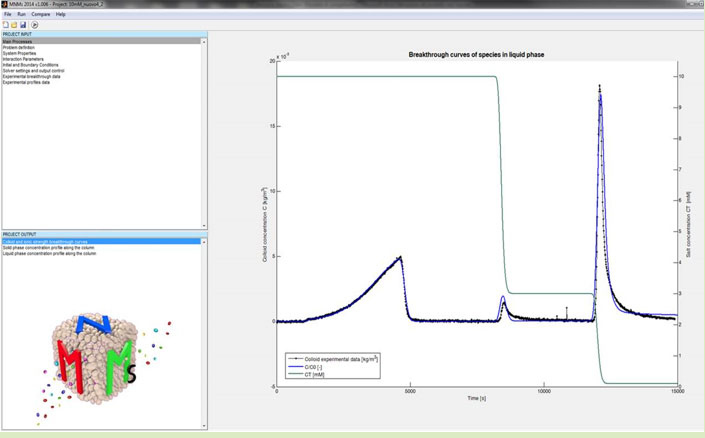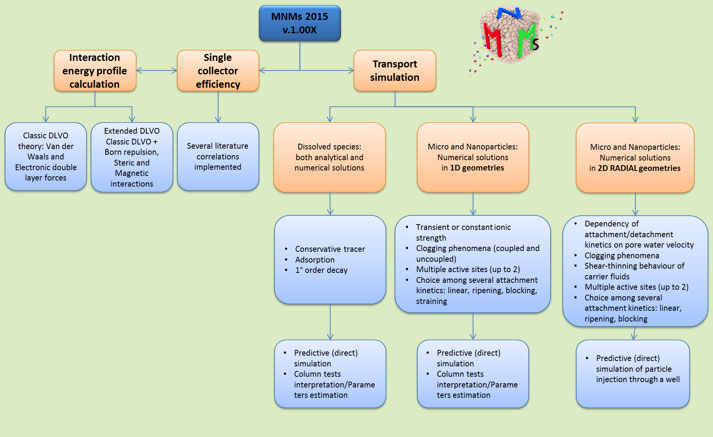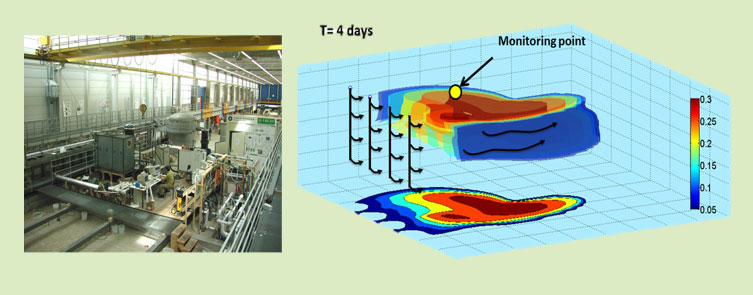WP 7 Objectives
• Developing a user‐friendly simulation tool (RT3D module) for the design and interpretation of laboratory tests and for predicting the fate and transport of nanoparticles and their effectiveness at the field scale.
• The simulation tool will make use of up-scaled relationships, to be developed from fundamental physico‐chemical principles and modelling, for describing mass transfer processes affecting the mobility of nanoparticles and their deposition onto and release from the porous medium, as well as interaction with dissolved substances. |
A key issue for field emplacement of reactive nanoparticles is assessing the mechanisms which control their mobility in the subsurface. Whilst transport of dissolved contaminants is thoroughly understood and many numerical models are commercially available to assist the design of a remediation intervention, fundamental factors that control the transport of nanoparticles in porous media are still largely unknown.

Predicting the mobility of nanoparticles in the subsurface underpins practical field applications. Whilst extensive literature is available on modelling approaches for colloid and virus transport in groundwater systems, models are commonly based on a modified advection-dispersion equation, with a term accounting for the exchange with the solid phase. The exchange terms are usually modelled with rudimentary empirical equations, which include particles deposition onto the solid matrix and their release.
Early stages of particle deposition are mainly controlled by particle-porous medium interactions (attachment); while in the second stage, particle-particle interactions prevail, especially repulsion or attraction of the particles (aggregation). The influence of pore water chemistry on physico-chemical interactions, and consequently on deposition and release kinetics, is well known and usually modelled with relationships empirically derived from laboratory data. The deposition of a relevant mass of particles may also affect the hydrodynamic properties of the porous medium, decreasing porosity and permeability, thus resulting in clogging phenomena (straining and ripening).

The coupling of the aforementioned phenomena was studied by Tosco and Sethi for viscous suspensions of iron colloids, and resulted in a numerical model for colloid transport simulation in 1D Cartesian and radial geometry (MNMs). However, this modelling approach is based on an empirical description of transport mechanisms, and not necessarily in line with the fundamental phenomena occurring at the micro-scale. Indeed, finding relationships derived from physico-chemical fundamental principles, verified and validated at the pore-scale, would represent a great step forward in the modelling approach.
Experimental studies are reported in the literature for micro-scale imaging of colloid retention in porous media, as well as numerical transport simulations which include pore-scale processes, but few studies are available which use the micro-scale results to provide a rigorous justification of the macroscopic deposition/release relationships. Moreover, modelling approaches which incorporate transport parameters obtained via averaging of pore-scale simulation results are lacking, as well as any systematic analysis on the effects of porous medium properties (porosity, tortuosity), particles properties (composition, size and concentration) and pore water chemistry (pH, ionic strength) on nanoparticle transport.
-
Physico-chemically based models that describe these phenomena are currently missing. By means of a multi-scale approach, NanoRem is intended to fill this gap, providing a numerical tool for large-scale simulation of nanoparticle transport based on physico-chemical fundamental principles
Numericaltechniques developed in NanoRem are being used to determine the parameters mostrelevant for transport and so advance up-scaling of nanoparticle use from thelab to field applications:
Fundamental understanding of nanoparticle transport in porous media. An extensive literature review was carried out with regards to transport of nanoparticles in porous media. Following this, a pore-scale network model (NanoPNM) was developed to provide a digital experimental environment. The model is being used to describe movement of nanoparticles and their interactions at the pore-scale. A wide range of properties (e.g. nanoparticle size, type, concentration, flow speed, surface properties, ionic strength) is incorporated into the model. Gravitational, hydrodynamic, electrostatic forces are also included. New pre- and post-processing tools generate the input and analyse the output of the many pore-network experiments. The necessary pore scale model parameters (pore size distribution, pore distance, and average pore connectivity, so called coordination number) for average sand were identified from the literature and a sensitivity analysis was performed for these parameters against common up-scaled parameters and rules for water flow, like porosity and Darcy’s law.

- Development of numerical design tool and design of field applications. A numerical tool for macro-scale simulation of solute and nanoparticles transport in porous media, called MNMs 2015 (http://areeweb.polito.it/ricerca/groundwater/software/MNMs.php) was developed and released for laboratory transport test design and interpretation.

- MNMs provides a user-friendly graphical interface for:
- calculation of interaction energy profiles according to an extended DLVO theory;
- Calculation of the single collector attachment efficiency using several classical and novel formulations (Messina et al. 2015) (http://www.sciencedirect.com/science/article/pii/S0021979715000594)
- solute and colloid transport in 1D (including linear and non-linear deposition kinetics under both constant and transients in ionic strength, clogging, non-Newtonian flow);
- nanoparticle radial injection for the preliminary design of pilot- and field-scale injections (WP8, WP10).
|

The ionic strength-dependent nanoparticle transport equations were also implemented in a RT3D-based plug-in, providing an extended tool for pilot- and field scale applications in complex 3D geometries. Numerical models have been created using Modflow for the simulation of flow and tracer transport in the two large-scale laboratory experiments. Preliminary transport simulations have been carried out.
